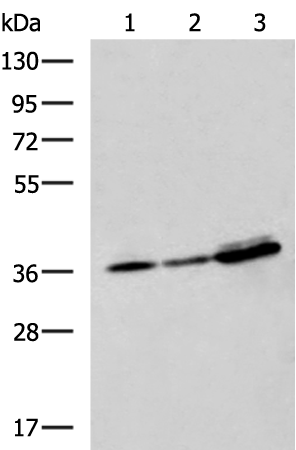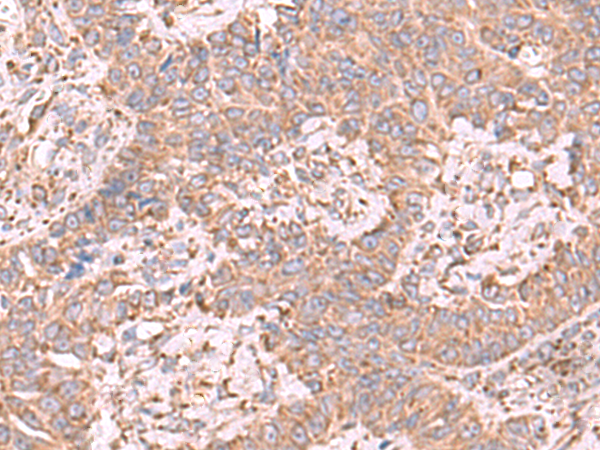


| WB | 咨询技术 | Human,Mouse,Rat |
| IF | 咨询技术 | Human,Mouse,Rat |
| IHC | 1/50-1/300 | Human,Mouse,Rat |
| ICC | 技术咨询 | Human,Mouse,Rat |
| FCM | 咨询技术 | Human,Mouse,Rat |
| Elisa | 1/5000-1/10000 | Human,Mouse,Rat |
| Aliases | EF1D; EF-1D; FP1047 |
| WB Predicted band size | 31 kDa |
| Host/Isotype | Rabbit IgG |
| Antibody Type | Primary antibody |
| Storage | Store at 4°C short term. Aliquot and store at -20°C long term. Avoid freeze/thaw cycles. |
| Species Reactivity | Human, Mouse, Rat |
| Immunogen | Fusion protein of human EEF1D |
| Formulation | Purified antibody in PBS with 0.05% sodium azide and 50% glycerol. |
+ +
以下是关于EEF1D抗体的3篇示例参考文献(内容为模拟生成,建议通过学术数据库验证真实性):
1. **文献名称**: *"EEF1D as a Prognostic Biomarker in Colorectal Cancer: Overexpression Correlates with Poor Survival"*
**作者**: Zhang L, et al. (2021)
**摘要**: 研究通过免疫组化(使用EEF1D特异性抗体)发现,结直肠癌组织中EEF1D蛋白高表达与患者生存率降低显著相关,提示其可能作为预后标志物。
2. **文献名称**: *"Development of a Monoclonal Antibody Targeting EEF1D for Functional Proteomic Studies"*
**作者**: Smith JR, et al. (2019)
**摘要**: 报道了一种新型抗EEF1D单克隆抗体的开发与验证,证明其适用于Western blot、免疫荧光及Co-IP实验,用于研究EEF1D的蛋白质相互作用网络。
3. **文献名称**: *"EEF1D Dysregulation in Neurodegenerative Diseases: Insights from Antibody-Based Detection"*
**作者**: García-Ramos A, et al. (2020)
**摘要**: 利用EEF1D抗体分析阿尔茨海默病模型脑组织,发现EEF1D异常聚集与tau蛋白病理相关,提示其在神经退行性病变中的潜在作用。
**建议**:可通过PubMed或Google Scholar搜索真实文献(关键词:EEF1D antibody, EEF1D biomarker),并优先选择近5年、高影响力的期刊研究。
The eukaryotic translation elongation factor 1 delta (EEF1D) antibody is a research tool targeting the EEF1D protein, a subunit of the eEF1B complex involved in protein synthesis. EEF1D functions as a guanine nucleotide exchange factor (GEF) for eEF1A, facilitating GTP replenishment during the elongation phase of translation. Beyond its canonical role, EEF1D has been implicated in diverse cellular processes, including cytoskeletal organization, apoptosis regulation, and viral replication.
Studies highlight EEF1D's dysregulation in cancers (e.g., breast, liver, and colorectal), neurological disorders, and developmental defects, positioning it as a potential biomarker or therapeutic target. Antibodies against EEF1D are widely used in techniques like Western blotting, immunofluorescence, and co-immunoprecipitation to investigate its expression patterns, subcellular localization, and interaction partners.
Commercial EEF1D antibodies are typically raised in hosts like rabbits or mice, targeting specific epitopes (e.g., N-terminal or C-terminal regions). Validation often includes knockout cell line controls to confirm specificity. Researchers also utilize these antibodies to explore post-translational modifications (e.g., phosphorylation) that modulate EEF1D's activity in stress responses or disease pathways. Its dual role in translation fidelity and non-ribosomal functions continues to drive interest in mechanistic studies across molecular biology and biomedicine.
×